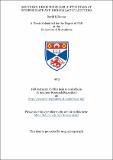Files in this item
Southern hemisphere early-type stars at intermediate and high galactic latitudes
Item metadata
| dc.contributor.author | Kilkenny, David | |
| dc.coverage.spatial | 131 p. | en_US |
| dc.date.accessioned | 2018-06-21T11:49:02Z | |
| dc.date.available | 2018-06-21T11:49:02Z | |
| dc.date.issued | 1973 | |
| dc.identifier.uri | https://hdl.handle.net/10023/14393 | |
| dc.description.abstract | A survey of early-type stars at intermediate galactic latitudes was carried out in the southern hemisphere winters of 1970 and 1971. The observing programme was limited to negative declinations and covered a range in right ascension of approximately 12ʰ to 20ʰ. At the Royal Observatory, Cape Town, in 1970, UBV photoelectric measurements were made of 56 stars for which no UBV data existed and 20 stars which had been observed on one or two previous occasions, the intention being to obtain four separate measures of each star. In 19711 the Bochum University telescope at the E.S.O. site in Chile was used for H/3 photoelectric photometry of over 200 intermediate and high latitude stars. Shortly afterwards, spectra for radial velocity determination and MK classification were obtained with the two-prism spectrograph and 74" reflector of Radcliffe Observatory, Pretoria. Work was concentrated upon some 60 stars not previously observed with spectroscopic equipment and selected on the basis of blue colour or possible high luminosity from photometric considerations. A few southern standard stars and stars from earlier Radcliffe programmes were re-observed as control or overlap stars. Chapters II - IV describe the observational procedures and reduction methods. Tables in chapter V contain results from the 1970-71 programmes plus UBV and spectroscopic data for intermediate and high latitude stars from various other sources. The remaining chapters are concerned with analysis and discussion of the observations. Chapter VI summarises some optical and radio determinations of the spiral structure of the Galaxy and compares the spatial distribution of the programme stars with these results. The possibility that early-type stars may be formed well away from the galactic plane is considered by comparison of kinematic and evolutionary lifetimes of some stars at appreciable distances from the plane. In chapter VII, intermediate and high latitude stars are shown to participate in the differential rotation of the Galaxy and detailed analysis of the space motions of a number of high velocity stars leads to the conclusion that some may .have sufficient energy to escape from the galactic system. The radial velocities of interstellar Ca II lines are shown in chapter VIII to be as expected for material in the solar neighbourhood involved in differential galactic rotation. An apparent deviation from circular motion reported by observers investigating H II regions is also present in the Ca II gas. Constants in the cosecant equation of interstellar reddening are re-determined and show an apparently significant difference between northern and southern galactic hemispheres. Appendix I describes attempts to simulate the effect of filters in order to explain the curvature in the transformations from instrumental to standard photometric systems. Appendix II gives details of the method used to compute stellar space velocities from proper motions and radial velocities and includes a short Fortran IV programme which implements the operations described. | en_US |
| dc.language.iso | en | en_US |
| dc.publisher | University of St Andrews | |
| dc.subject.lcc | QB843.B8 | |
| dc.subject.lcsh | Early stars | en |
| dc.title | Southern hemisphere early-type stars at intermediate and high galactic latitudes | en_US |
| dc.type | Thesis | en_US |
| dc.type.qualificationlevel | Doctoral | en_US |
| dc.type.qualificationname | PhD Doctor of Philosophy | en_US |
| dc.publisher.institution | The University of St Andrews | en_US |
This item appears in the following Collection(s)
Items in the St Andrews Research Repository are protected by copyright, with all rights reserved, unless otherwise indicated.

